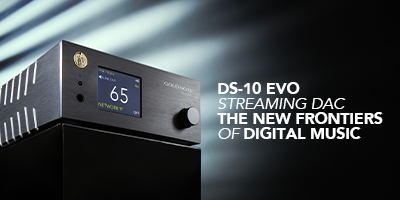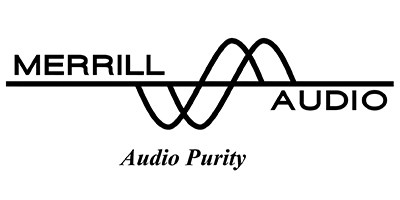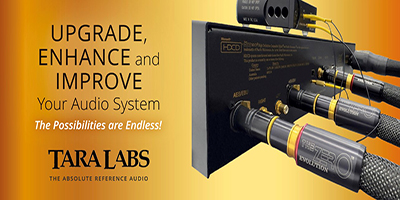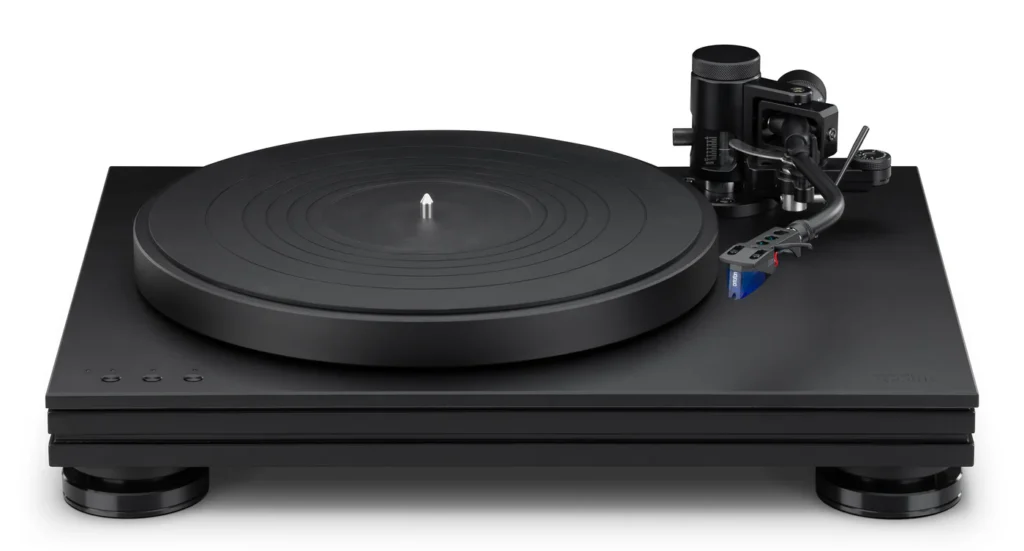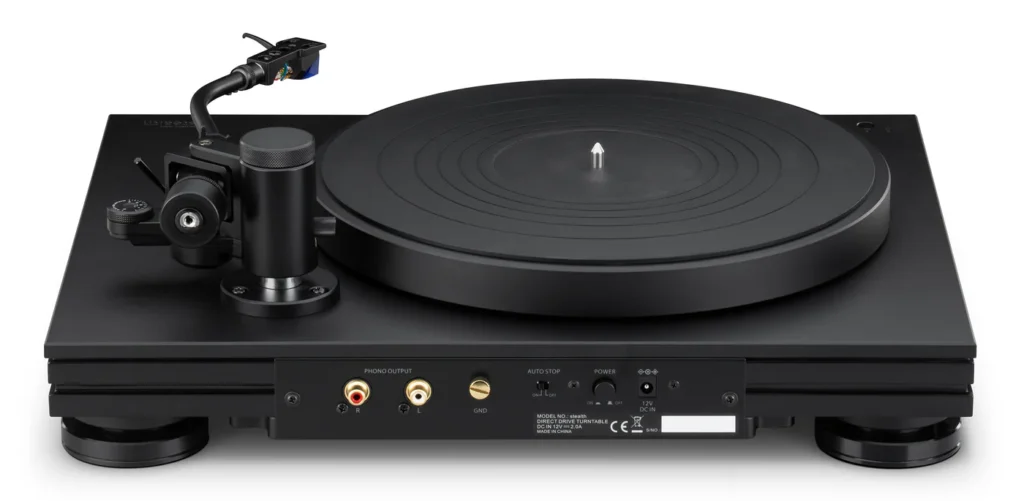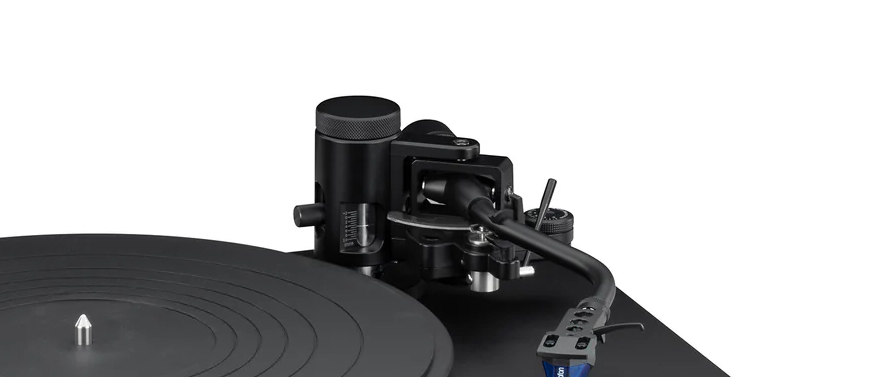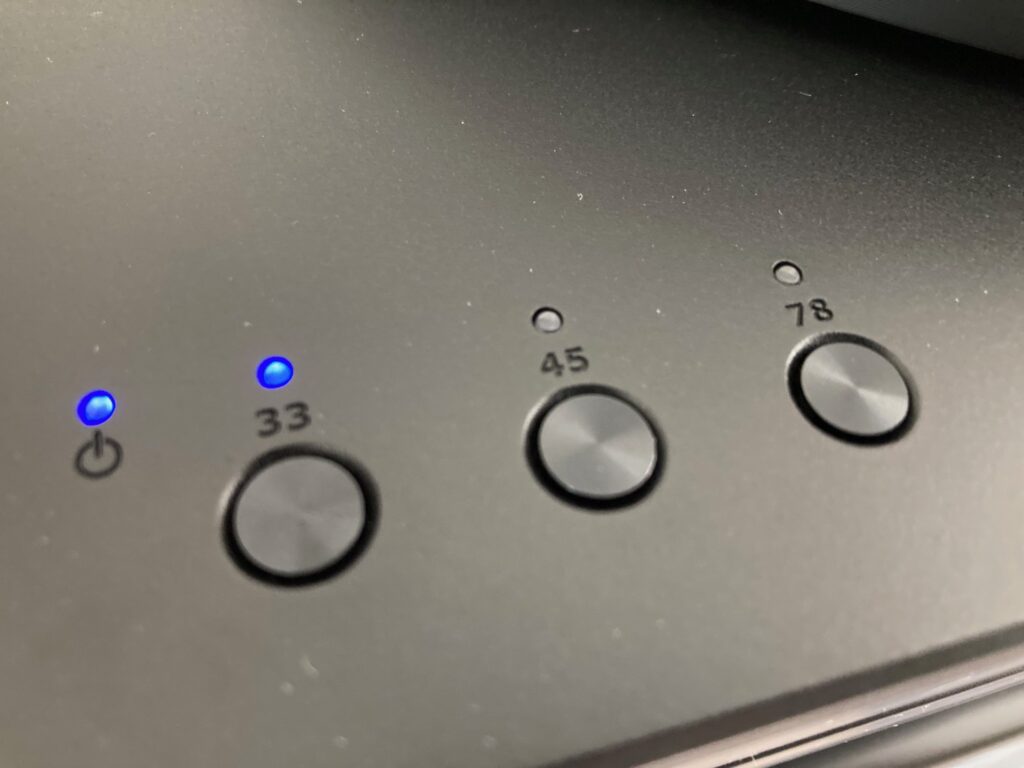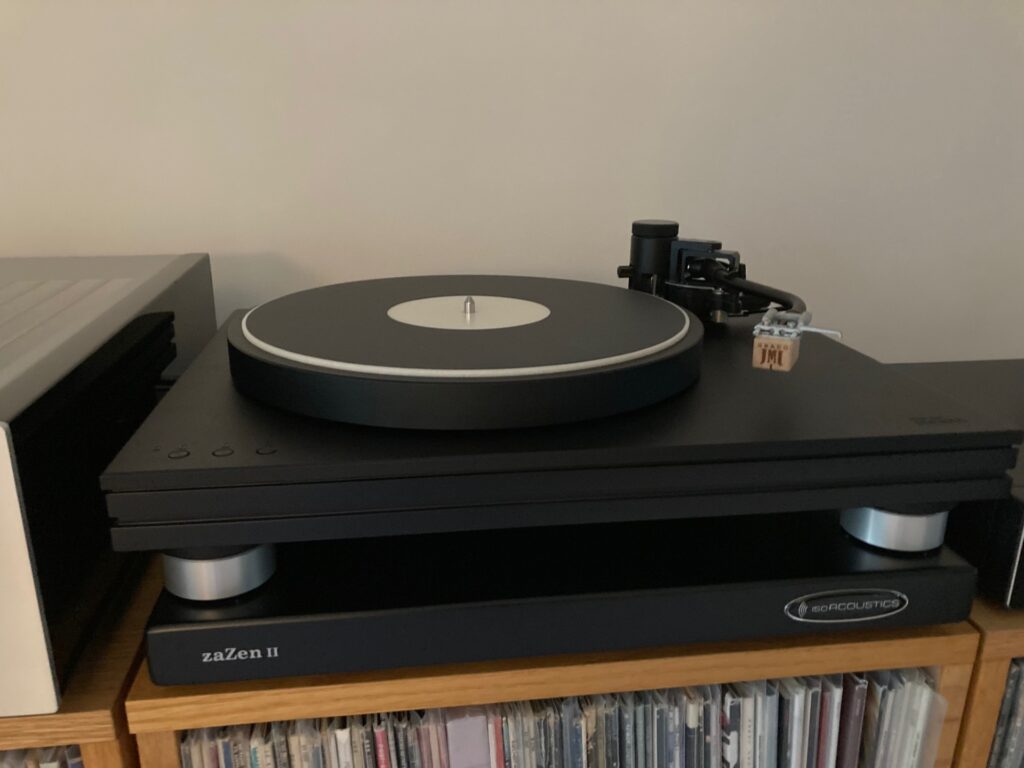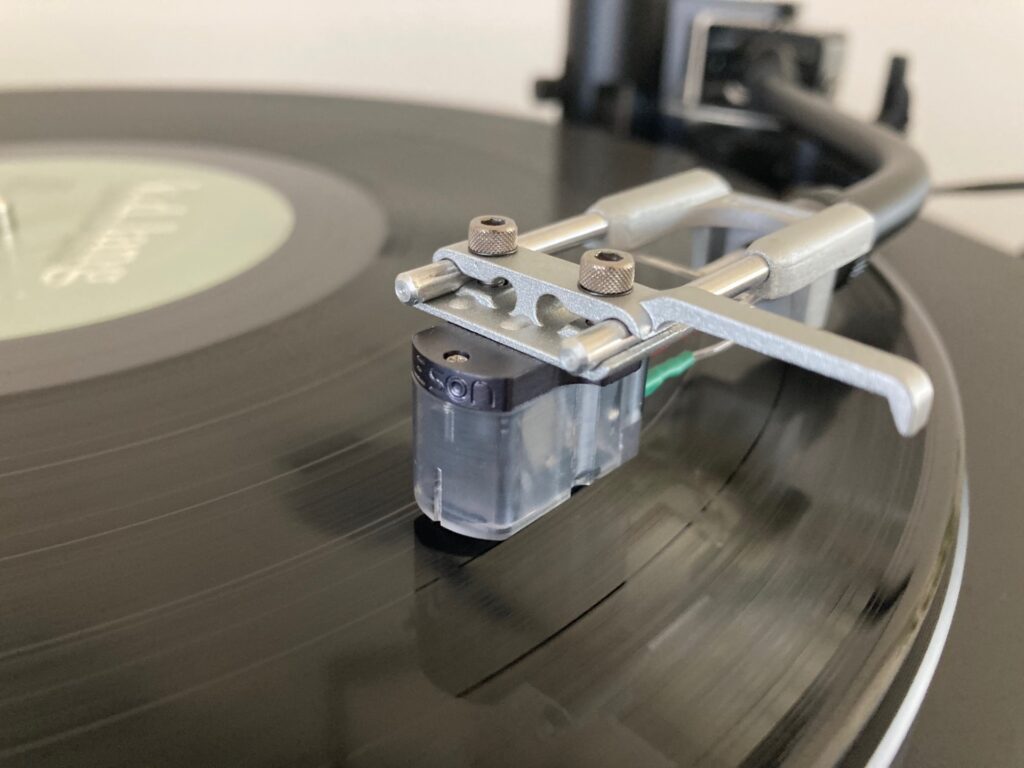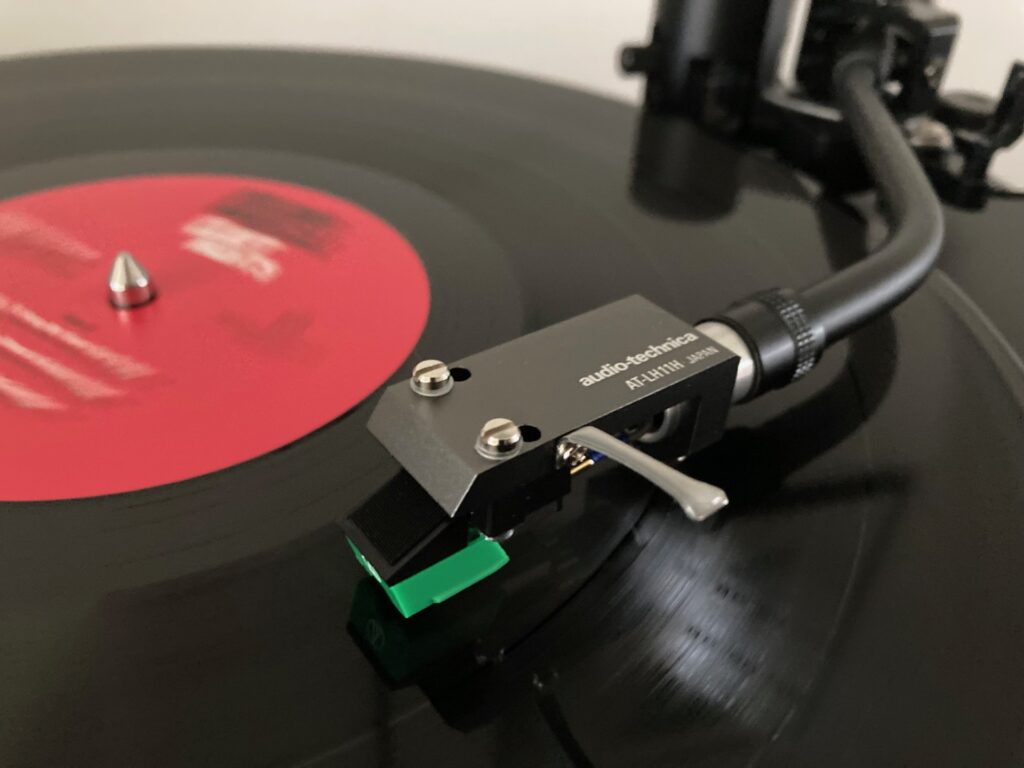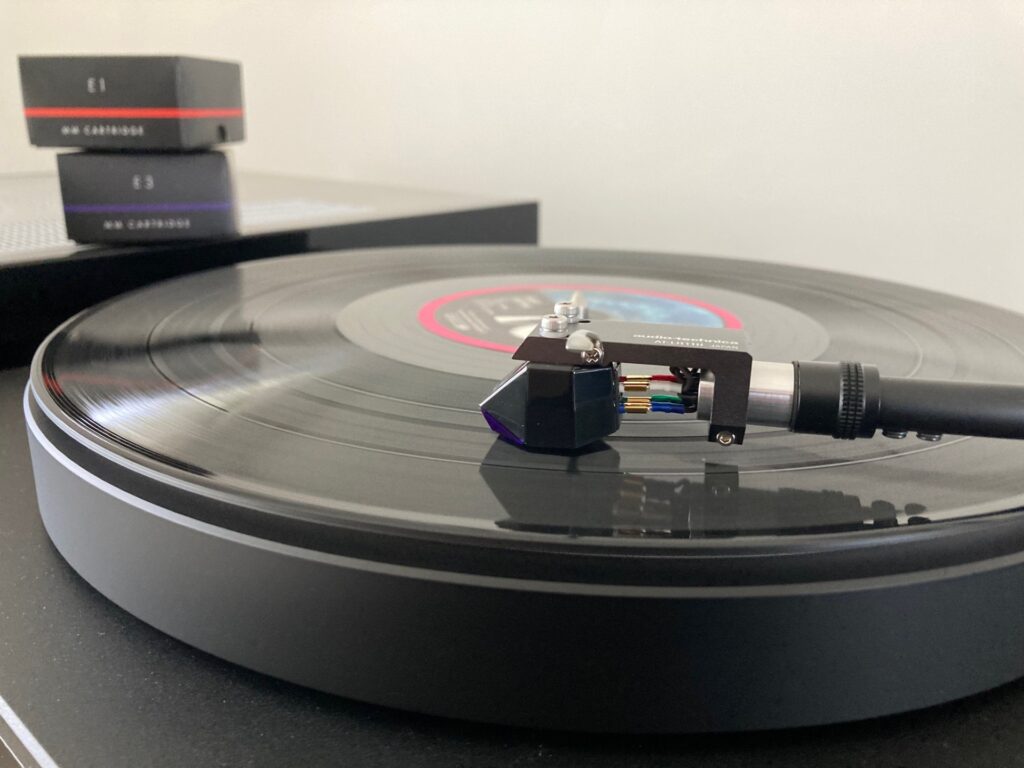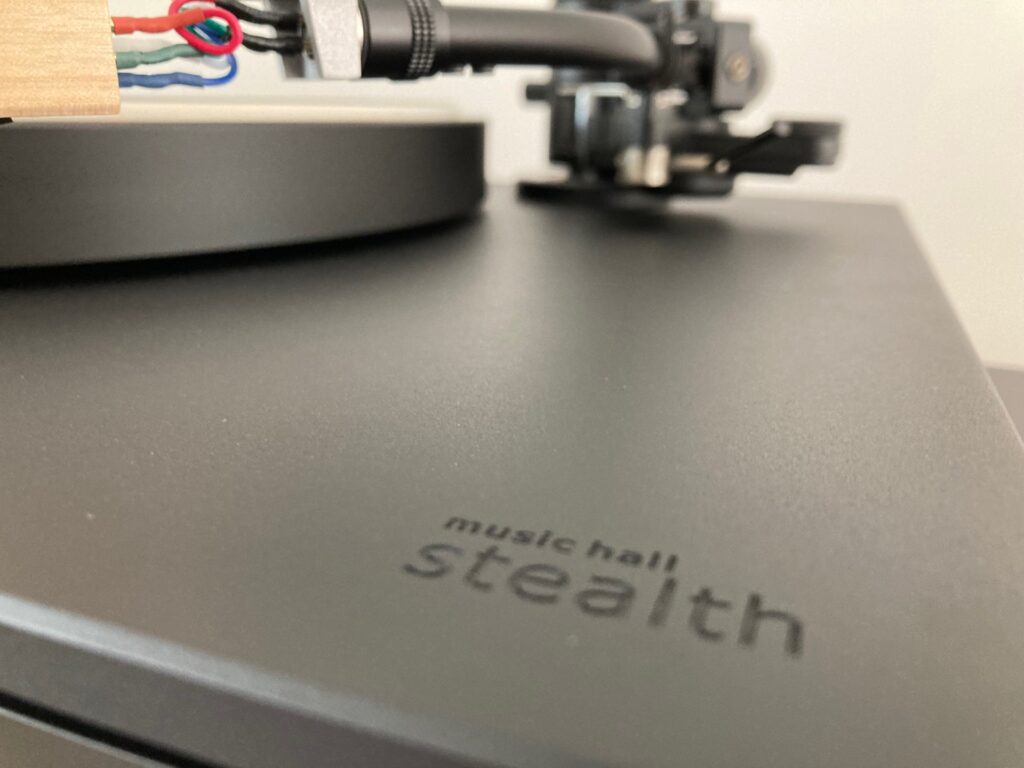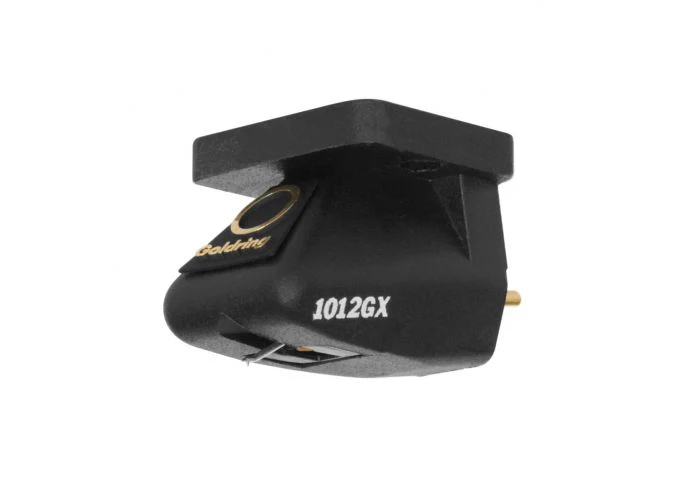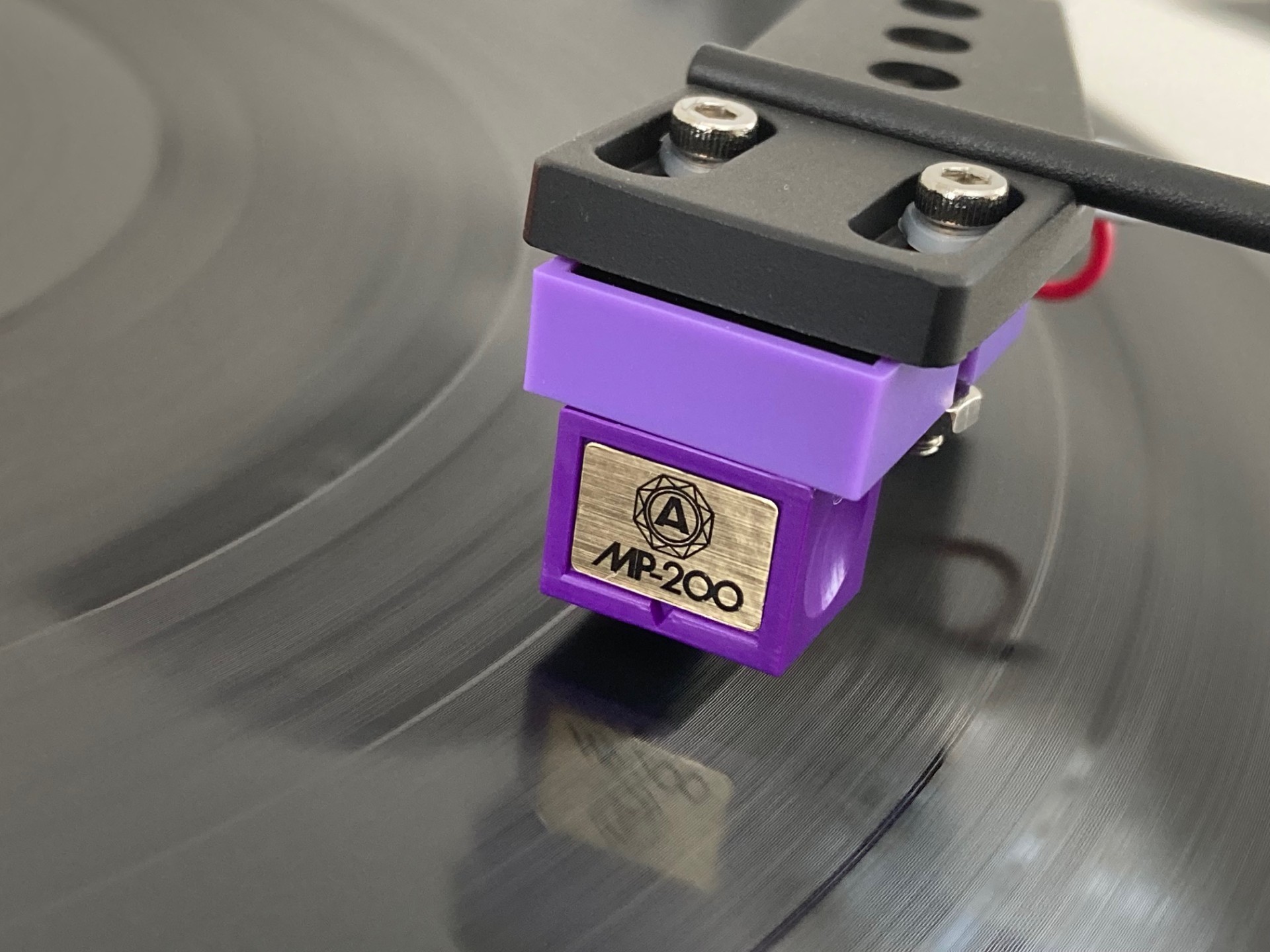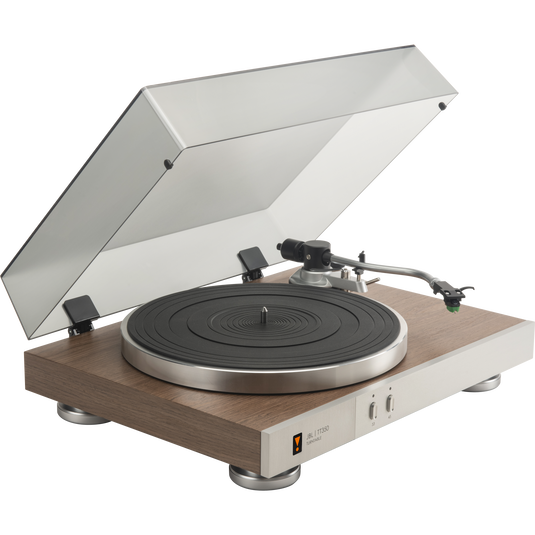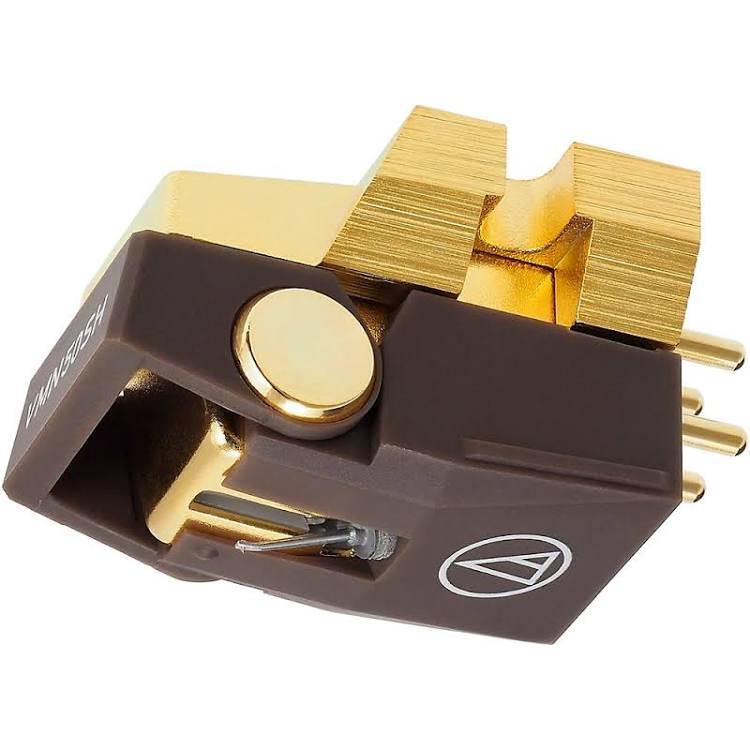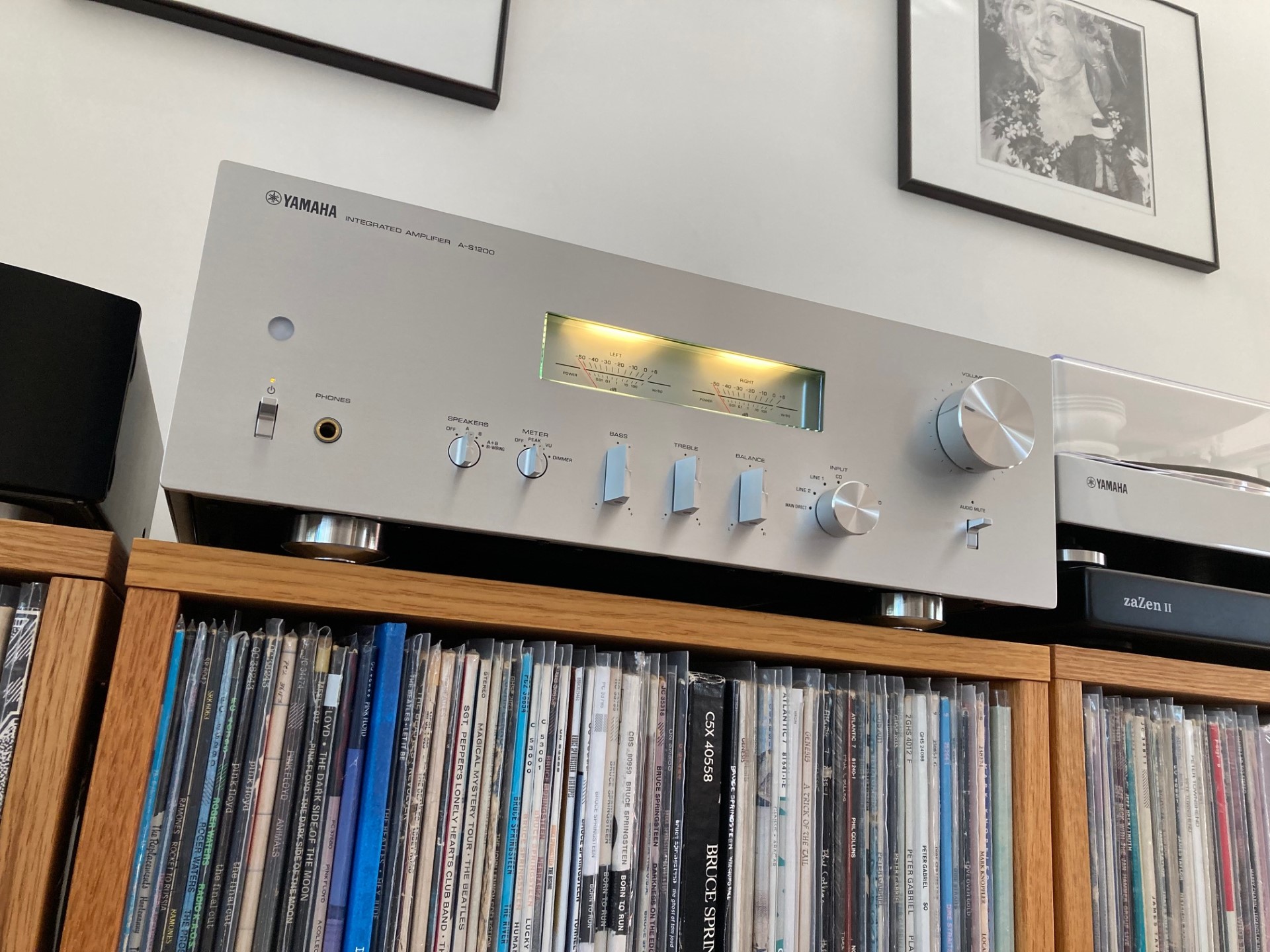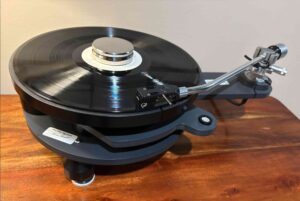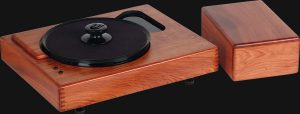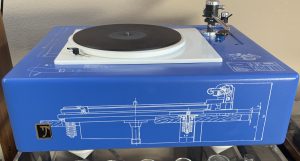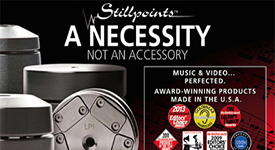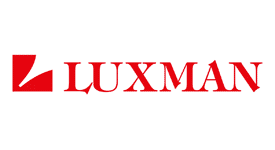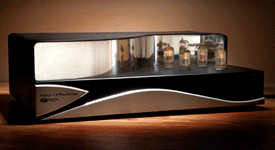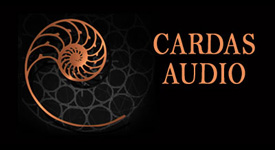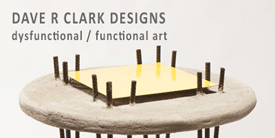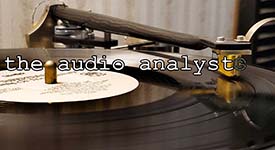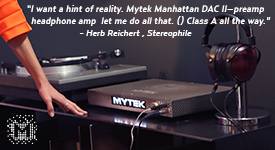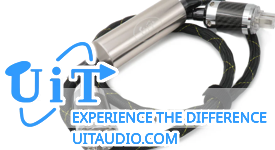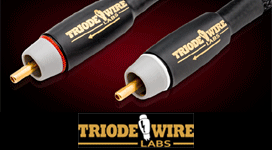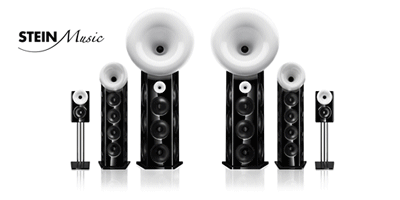I threw everything but the kitchen sink at this relatively affordable Darth Vader-looking contraption in terms of upgrades. Not because it's bad, but rather, because it's very, very good. It sounds and feels more like a $2500 product than something priced at $1649, including cartridge. Could a few, well-chosen and easily installed swaps make it sound more like $3000 or $4000, for a fraction of the cost? I could easily tell you right now, but writers love building suspense.
So, before we get there, you may be asking: why bother reviewing a turntable that has already been around for a few years? First, because I had such an enjoyable experience with Music Hall's $649 Classic (HERE) that I wondered what the brand could do for a full $1000 more. Second, because I have an undying affection for direct drive players, going all the way back to my bought-new Denon DP-47F and on to the original Technics 1200 series right up to the current SL-1200MK7 and SL-100C, not to mention the JBL TT350 and several others, all of which I have spent lots of time listening to. Finally, because all of those products have benefited to some degree from the kind of simple upgrades I'm alluding to: feet, mats, headshells, cables, and cartridges. Music Hall had to cut corners somewhere, after all.
Well, all that, and this: the Music Hall Stealth is seemingly manufactured at one of the much-maligned factories that turn out affordable DJ and "lifestyle" turntables for a myriad of brands these days. I reviewed one of them HERE—Audio Technica's AT-LP1240USB—and have heard several others in my home from Yamaha, Reloop, and Cambridge Audio. They've mostly been varying degrees of quite good, except for one that will remain unnamed, and some have been downright overachieving, especially the direct drive models. What happens when a company like Music Hall gives the builder a bigger budget to work with and commensurately higher performance targets to meet? I had to know.
Looks that look like they kill
Now, I can't say I love the Stealth's sinister, Death Star aesthetic. That's purely personal, but man is this thing kind of severe looking: so much so that, even though I'm sure it has been covered elsewhere, it's impossible not to comment on. It reminds me of the all-black Porsche 911 cabriolet somebody in my neighborhood paid a lot of money for: black paint, black wheels, black fabric roof, and I'm assuming a black interior, but I can't tell due to the black window tint. (Presumably though, the infotainment screen displays a color or two.) Likewise, though the Stealth has tiny (and thankfully, not overly bright) red/blue LED indicator lights for power and speed, it's otherwise all black save for the markings on the counterweight and anti-skating knob. Even the brand and model name are embossed into the plinth so as not to interrupt the night sky aesthetic. A silver-toned platter would at least introduce a little contrast. I much prefer the softer, more—ahem, classic—look of the Classic.
But this, on the other hand, is a far more purist design that is every bit the heavy, seemingly overbuilt, outwardly serious product its purposeful design promises. At around 24 lbs, and with a genuinely heavy platter, it certainly has the sheer mass befitting more upmarket models. I'm sure some of it is simply weight for weight's sake, but it works. Anyway, the Stealth certainly lives up to its name, and there's nothing to criticize about the build quality… no rough edges, no loose fits, no seeping glue, no tonearm bearing quibbles. It grew on me pretty quickly. Thinking back, my Avid Diva II was also all black, yet somehow the more skeletal design didn't seem so oppressively apocalyptic.
Solid, sensible bones
The Stealth's tonearm is a quality item. Music Hall does not state the exact effective mass figure anywhere, but when contacted, they told me it was "medium," and vague though that is, it also feels about right considering how happily it got along with cartridges of varying compliance. Worth noting: much has been made of the Stealth's VTA adjustment tower, with many users describing it as offering "on the fly" adjustment. In reality? Not so much. You won't want to use it while a record is playing, and I don't think Music Hall ever intended it as such. It's a little loose when unlocked, so at a minimum, you'll want to lift the tonearm before making adjustments lest you send the stylus skidding across your record. Technics tables with their VTA ring, by comparison, can indeed be adjusted on the fly… if you're careful. The extent to which that's genuinely useful is debatable.
Music Hall includes a good set of phono cables with ground wire, as well as a supplemental counterweight that screws onto the back of the toneram to help balance heavier cartridges down the road. The included Ortofon 2M Blue, which I reviewed HERE back in the day, is always nice to see and will certainly get you started. And getting started is simple, since it's pre-mounted and adjusted on an included, lightweight, universal-style headshell. So, despite the Stealth's higher-end pretensions, it's as easy to assemble as the Music Hall Classic: plug in the wall wart power supply, attach the platter and mat, level it with the adjustable feet, screw in the headshell and counterweight, balance the arm, and set the tracking force. Five minutes. You don't have to be an analog expert to use it as long as you can write the check to buy it.
The well-done protective packaging and double-boxing kept everything safe in transit. A nice fabric dust cover is included though I would vastly prefer something more like a clear acrylic overlay that sits on the platter and juts up over the tonearm. The fabric cover does just fine for long periods of inactivity, except that being floppy, it could catch a cartridge's cantilever if you're too hasty pulling it off. To be safe, fit your cartridge with its stylus guard before putting the cover on.
The included 2M Blue cartridge is a canny match for the Stealth, though I had to cycle through several other cartridges before I realized why. As it turns out, despite its mil-spec looks, the Stealth is kind of warm-sounding. The rather crisp, some might say slightly digital, sound of the 2M provided a nice counter balance. Don't get me wrong, the Stealth doesn't need substantial perking up, nor does it necessarily drag down cartridges with a warmer balance. But the overall sound is chunky and substantial, with a musical weight and grounding that many tables lack, which is probably why cartridges that have a more prominent sense of focus on the treble work well.
Simple and user-friendly
The Stealth comes up to speed quickly by pressing the button for your desired speed, but takes a few seconds longer to stabilize than a new Technics as confirmed by the RPM speed app and my own ears. This is not a fault, but probably due to the presumably low torque motor's inherent characteristics. It's also not a problem during typical usage unless you enjoy playing dusty records, because by the time you're done running a dry brush over one for a few revolutions, the speed is locked in and stable. Pressing the same speed selector button again stops the platter, and it seems like there's a little braking effect because it also stops quickly. That's a nice touch as it means less waiting between sides, especially when playing 45 rpm records with short running times.
The power button is around back, but it's easy to locate by feel since it's the only button, and hiding it contributes to the Stealth's uncluttered exterior. There's also a switch for the defeatable, optically-triggered autostop feature that halts the platter after about half a minute of a record's end to reduce stylus wear in case the unit is left unattended or the user falls asleep. It worked flawlessly throughout my time with the Stealth, and I found it occasionally useful if only as a fail safe. Also, because there is no accompanying mechanism to lift the tonearm, zero potential exists for any sonically harmful drag or tension on the tonearm, as you'd hope for in a purist design.
Eight legs to stand on
My living room, which is located above a finished basement and cursed with slightly squeaky floors, isn't the best place for a turntable. Yeah, yeah, I know, get a wall-mounted shelf you say, and you're probably right, but I just don't like them. Therefore, I've settled on a two-tiered approach to vibration control for most situations. An Isoacoustics ZaZen platform does a good job of filtering out low-level, steady-state vibrations like those caused by refrigerator motors or AC compressors. Then comes a set of hopefully springy turntable feet for mitigating big shocks like footfalls. These things together usually work better than one or the other.
The Stealth's plastic stock feet are ordinary looking but fit the bill. They're substantial and just springy enough. I substituted a set of Isonoe feet (about $180) and couldn't tell any difference. However, I like their looks better so I stuck with them since they certainly didn't do any harm, and besides, they were just sitting in a drawer collecting dust and not earning their keep in any way whatsoever. If you want to mess around with other options, any feet with an M6 thread and a suitable weight capacity should be compatible.
Power supply swapping and mat muddling
The Stealth's stock wall wart power supply feels like the exact same thing you'd get with a $15 clock radio, so I upped the ante using a $119 iFi PowerX wall wart. Now, good as the iFi is engineering-wise, it's still a far cry from the outboard box on my old Avid or something like a Linn Lingo. As such, I wasn't expecting much here, if anything at all. But since it was easy A-B testing the stock wall wart against the iFi, I just kept both connected to the same power conditioner and swapped plugs at will.
If you put a gun to my head, I'd say I think I heard a very slightly better defined, more precise, controlled and less warm sound with the iFi instead of using the Stealth's wall wart. I wouldn't bet my life on it, or even an insubstantial amount of cash, but there it is. Maybe the difference would be more pronounced in a home with really janky AC, and maybe it would be nonexistent elsewhere, but for $119 with a money-back guarantee, it's an extremely low-risk purchase and worth a try. I'm keeping it and using the one that came with the Stealth as a backup, just in case. Good on iFi for trying something and letting purchasers judge for themselves whether it makes a difference in their particular application.
A Herbie's Way mat (HERE) has always delivered genuine added value. I've been using the same one for years, on more turntables than I can remember, and this closed-cell foam disc remains, for me, the most versatile and reliable affordable mat out there. On the Stealth, compared with the stock rubber mat, the backgrounds were blacker, instruments better defined, and everything more natural and less hard-sounding. Yet the stiffer, far less easy to use Funk Firm Achromat had equally compelling virtues, doing what the Herbie's mat did but also slightly increasing spaciousness and sharpening transient reproduction. Again, minor differences, but for around $100 each, it might be worth trying both.
Here's why: the Achromat seemed to tighten up softer and more color-rich cartridges like the Grado Opus3, while the Herbie's mat calmed down cartridges with a slightly more prominent high-end like Goldring's 1012GX. That said, fiddling with the Funk's included double-stick tape discs that are, in my experience, required to make the Achromat lie flat and interface properly with the platter may be a deal killer for some. Maybe an acrylic, carbon fiber or cork/rubber mat would provide similar results with less hassle. Three mats per turntable review is my limit, but by all means, please leave a comment if you try something else and like it. I'd love to hear about it.
Horses and saddles
Cartridge-wise, we've already briefly touched on the Grado Opus3 and Goldring 1012GX, both very different and excellent in their own ways. Other candidates for a softer, more romantic sound include Shelter's $350 201 or any Nagaoka MP series model of your choosing, while certainly any Audio-Technica in the VM95 or VM500/700 series would perk things up.
Late in the review, the new Le Son MK II high-output moving coil arrived with its boron cantilever, line-contact diamond and irresistible $499 intro price. Early verdict: it blows away just about any price-competitive, high-output MC I know of in terms of clarity and detail, and competes at the same level as the old $850 Hana SH (which has been replaced with an upgraded model) and even keeps up with the always entertaining $895 Dynavector 10x4 Mk II. (Only time will tell if it's as durable and nice to listen to over the long term as those more established models.) Goldring's modest and overachieving E1 and E3—just $129 and $189, respectively—were slightly more appealing to my individual preferences than the included Ortofon 2M Blue, which is hardly an also-ran, but the E3's tonal color trumped the Blue's more digital-like balance.
Finally, I couldn't help but invoke the tried-and-true test of an excellent table's mettle: its ability to still sound excellent even with a modest cartridge. Well, it doesn't get much more modest than Audio-Technica's ubiquitous AT95E—not the current and more refined AT-VM95E, mind you, but the officially discontinued (yet seemingly still available in perpetuity) basic model dating back to the 1980s for around $40. Standard on countless entry-level turntables for decades, not to mention quite a few that were decidedly much better than entry level, it can sound crappy on crappy tables but very good on better ones. Boy, was I in for a pleasant surprise.
This old warhorse didn't disappoint, and in fact, it activated the Stealth's boogie lobe better than the other cartridges I tried. It was fun and notably dynamic, moving the beat along with alacrity and some grace. Though the body is brittle plastic and its stylus barely qualifies as elliptical, the AT95E displayed impressive cohesiveness anchored by a natural midrange, little opaqueness, credible soundstaging and outstanding tunefulness. The Stealth tamed the crunchiness I've heard from it on cheap tables, resulting in a superbly balanced overall sound. If you told me that, in this application, the AT95E was a really nice $150 cartridge, I'd believe you. Oh, and when I swapped out the AT95's stock stylus for a $119 aftermarket hyper-elliptical from TurntableNeedles.com (stock #710-DHE), it retained all of its virtues but assumed a more smooth, assured and textured character. If you already have an AT95 body laying around, it might be some of the best $119 you ever spend.
The Stealth merits a strong A-grade here: it unquestionably got the most I've ever heard out of this "freebie" cartridge… and if it can do that with this, it means we're dealing with an all-around well done unit. Any lingering doubts I had about the tonearm went right out the window. It also occurred to me that Music Hall markets a $100 version of the AT95 they call the Spirit that comes standard on the Classic turntable, and honestly, I wish they offered it as an option to bring down the Stealth's price from $1649 to, say, $1549.
Headshells, of course, are another matter. While the Stealth's included headshell is perfectly fine, it's rather lightweight—ideal for the included 2M Blue—but lower compliance cartridges still may prefer something like an Ortofon LH-2000. That will necessitate using the Stealth's included auxiliary counterweight to balance the tonearm. (Side note: the Stealth's arm, clearly patterned after Technics right down to its basic dimensions, even accepts Technics 1200 series auxiliary screw-in counterweights, so if you ever lose the one that came with the table and your Music Hall dealer is unable to locate a replacement part, you could always go that way.)
Generally, headshell swapping wasn't revelatory in my listening, with mostly slight differences between generic headshells and premium models from the likes of Audio-Technica, Ortofon, Yamamoto and some vintage goodies from Orsonic. Still, I don't think that carefully-judged experimentation in this area is unwarranted, and while the performance differences may be minor relative to the package as a whole, it never hurts to have different headshells of varying weights and characteristics available for practical reasons like compliance matching or the ability to adjust azimuth, with the Stealth's tonearm lacks. Is it rational to keep a couple thousand dollars worth of headshells around, like I do? Judge not lest ye be judged.
All that said, my top pick for the Stealth by a mile is Audio-Technica's 11-gram AT-LH11H (pictured above) which costs about $100. It's very rigid, beautifully finished, comes with nice OFC wire leads, and works equally well with cartridges that do and don't have threaded mounting screw holes. Most importantly, it offers azimuth adjustment, which the Steath's tonearm lacks. It only has two sets of fixed openings for screws because it also offers slick telescoping overhang adjustment. You simply pick the most advantageous of the two openings, install the cartridge, and then loosen a grub screw on the headshell's side to slide it back and forth on a track for fore and aft positioning of the cartridge. It's damn nice, and audibly superior to a standard Technics knockoff headshell. Although available in higher weights than 11 grams, since the Stealth's tonearm is already medium mass, I'd skip the 13- through 18-gram variants. (Bonus: because the headshell track moves during setup instead of the cartridge, re-mounting the same model of cartridge after retipping should require little to no realignment, assuming the cartridge manufacturer knows how to make a straight cantilever and stylus.)
The all-around sound
I previously said that the Stealth was kind of warm sounding. That deserves more explanation since it's subtle. The more I listened, I noticed the Stealth didn't do design shortcoming-related additives. For instance, on lesser tables, there's often a ringy platter or loose tonearm bearings that can affect the sound and give it artificial zip. Not here. The Stealth possesses the serious, resolute nature of more expensive tables that also prioritize heft, damping and solidity. There just seems to be a slight disconnect between its ability to go really low and reproduce bass that's tight and deep, but not quite as high on the other end of the spectrum in terms of air and space around high frequencies. This might go completely unnoticed in systems with limited low frequency extension. Those impressions held true whether played through the inbuilt phono preamp of my Yamaha A-S1200 integrated amp, or using the standalone Avid Pulsus or Pro-Ject Phono Box DS+ (with aftermarket linear power supply).
Also, while the Stealth is resolving in the same nonchalant way that most components are once you get far enough from the entry level, it seemed to trade off some lightness and fun. I listened to Peter Gabriel (I/O) and Diana Krall (All For You) back-to-back on the Stealth and $699 Yamaha TT-N503 (upgraded with Shelter 201 cartridge and Oyaide BR-12 mat) and the Yamaha was perkier, bouncier and got my toes tapping more decisively than the Stealth. In that regard, the Yamaha sounded eerily like my old Linn LP12 with Valhalla power supply. In fairness, the Yamaha did everything else substantially less well, presenting a more homogeneous musical picture that brought everything to the foreground, without the Stealth's depth, dimensionality and layering.
Despite the Stealth's direct drive architecture, it's no disco machine. It moves the music along naturally and never sounds slow for even a second, but it's not overtly propulsive. Perhaps, compared to some other direct drives, it's more truthful and less, well, direct drivey. I suppose whether it's for you comes down to what's more likely to draw you into the music: thought-provoking complexity and insight, or upfrontness and boogie. Sometimes, frankly, I'm in the mood for either, which is probably why I've hung onto the Yamaha, though just as frankly, its appearances on my turntable shelf are generally not long lived.
As you'd expect from a high-mass design, the Stealth throws a pretty impressive soundstage for the price. It's easy to forget that this is a $1649 product, but good as it is, this particular aspect of the Stealth's performance doesn't overachieve as notably as others. (It was here in my notes that a pattern began to emerge: I was spoiled enough by the Stealth that I only seemed to notice when it failed to substantially exceed expectations.) Image solidity and placement were excellent however, aided by the Stealth's ability to sort out disparate timbres and tones. The IsoAcoustics platform and Isonoe feet may have helped in this regard, but I can't say for certain since I didn't do an A-B comparison without them.
Mature and confident were the first words that came to mind when listening to the Stealth in stock form, and those were still my impressions after judicious tweaking. Was it all for naught? Maybe, but the extra fiddling around made me appreciate how well sorted the Stealth is right out of the box, so much so that I'd think twice about tweaking it if I had to buy all that stuff rather than having it on hand. I don't love the included rubber mat, and cartridges are a matter of taste, but this is a table that arrives at your doorstep ready to roll. One thing I always appreciated about former Music Hall owner Roy Hall is that he never made turntable design sound like alchemy. The Stealth, which may be his swan song as the full time company honcho, is proof that sensibly combining good quality parts in proven ways and informed by decades of experience usually can't fail. It certainly doesn't here.
I suppose, at this price, one question arises more than others in terms of comparison shopping direct drive tables: can a Stealth with a few hundred dollars in upgrades stack up to the more recently released $2200 Technics SL-1200GR2? I haven't yet auditioned the new and improved 1200, but I've owned the lower-priced SL-1200MK7 (HERE) as well as the SL-100C. Many people say that both offer a sizable chunk of their bigger brother's performance. Assuming that's true, then I can say the Stealth is fully worth a listen if you're considering any of the Technics tables. Certainly, my firsthand experience says it's better (but different than) the MK7 and 100C, as it should be for $550 more: a little warmer, a little less clinically precise, and with less drive, but offering a subtler, more mature and fleshed-out sound. Incidentally, I also tried the modest AT95 cartridge (in tweaked AT95EX form) on those tables, and it didn't sound as accomplished as it did on the Stealth.
Inconclusive conclusions (about the tweaks, not the table)
You should expect fewer, and less consequential, compromises as you move up the price ladder, and Music Hall's Stealth is a prime example. It's hard to say whether some of the tweaks I tried made much of a difference, and aside from cartridges and mats, even the tweaks that did stand out collectively only moved the needle a little. So, for me, the answer to whether some well-chosen upgrades can elevate its performance to compete with turntables in the next price class is no. That's not bad news though, because Music Hall's Stealth is, in most ways, an unqualified success. If you want a taste of the resoluteness and solidity that $5000 turntable packages deliver—for around ⅓ the price—put the Stealth very high on your list.
And if you also want that in a package that's easy to use and maintain and comes ready to play out of the box, the Stealth becomes even more enticing. Upgrade the cartridge and it keeps on delivering more detail, refinement, space, texture and color. Or downgrade the cartridge and upgrade the headshell perhaps, because the modest Audio-Technica AT95E and AT-LH11H were the most musically satisfying combination I tried: great with pop, rock, and especially jazz, if not quite so much with large-scale classical music, though it easily captured the thrill and bombast of various recordings if not the nuances. Really. Synergy is a peculiar thing, and often, the higher-priced product isn't necessarily the best choice.
But you can't have everything for $1649, and here, the Stealth lacks a little (though very little) of the outright fun, top-end extension and lightness that some people find appealing about music listening. In that case, you might do better with a Rega Planar 6 or Music Hall's own MMF-7.3. In exchange, the Stealth offers a big, tight, grounded, determined, resolving but still hardly staid sound. If it aligns with your sensibilities, it's unquestionably one of the most compelling, talented, solid and value-packed turntable packages I've ever encountered. The worst I can say is that it occasionally only lives up to its price point instead of transcending it. That's the sort of demerit that lesser products would kill for. I'll say this to Music Hall's new owners: keep it in your lineup and don't change it.
Specifications
- Turntable Type: 3-speed full manual, Auto stop
- Cartridge Type: Moving magnetic cartridge
- Motor: Brushless motor (Low torque)
- Driving Method: Direct drive
- Turntable Platter: 305mm (12") dia. Aluminum die-cast
- Speed: 33 1/3, 45 and 78rpm
- Wow and Flutter: Typical: Less than 0.07% WTD at 3kHz RMS (CD-4005), Limit: Less than 0.12% WTD at 3kHz RMS (CD-4005)
- Signal-to-noise ratio (for MM): Typical: More than 70dB DIN-B (SS-4242), Limit: More than 65dB DIN-B (SS-4242)
- Speed Tolerance: Constant Speed 3000Hz +/-0.3% (CD-4005)
- Channel Separation: Typical: More than 20 dB at 1kHz (CD-4005), Limit: More than 15 dB at 1kHz (CD-4005)
- Channel Balance: Typical: Within 1.5 dB at 1kHz (CD-4005), Limit: Within 2 dB at 1kHz (CD-4005)
- Phono Output Level: Typical: 5.5mV -3dB/+1dB: 3.894mV6.172mV at 1KHz 5cm/sec (CD-4005), Limit: 5.5mV -4dB/+2dB: 3.471mV6.925mV at 1KHz 5cm/sec (CD-4005)
- Frequency Response (Phono Output): Typical: 20Hz20kHz +/-0.5dB, Limit: 20Hz20kHz +/-1dB
- Brushless motors torque (Direct drive): Typical: More than 1.2kg, Limit: More than 1.0kg
- Power Supply: DC12V,2.0A
- Standby Power consumption: Less than 0.3 W, Auto stop on more than 20 minutes
- Dimensions (WxDxH): 17.83" x 14.24" x 5.78" (455 x 361.67 x 146.7mm)
- Weight: 24 lbs.(11 Kgs)
- Cartridge: Ortofon 2M (Bule)
- Output Voltage: 5.5mV at 1 kHz, (5 cm/sec)
- Channel Separation: Measurement point 1KHz over 25dB
- Channel Balance: 1.5dB or less at 1kHz
- Frequency Response: 20Hz ~ 20kHz +2/-1 dB
- Vertical Tracking Force: 1.6~2.0g (1.8g, Recommended)
Tonearm
- Type: Static balanced S-shaped tonearm with detachable head shell
- Effective Arm Length: 230mm (9")
- Overhang: 15mm (0.59")
- Offset angle: 22⁰
- Tracking Error Angle: Less than 3 degree
- Applicable cartridge weight: 6~10g
- Anti-skating adjustment range: 0~4g
- Height of cue (first track): 8~10.5mm
Stealth Turntable
Retail: $1649
Music Hall

